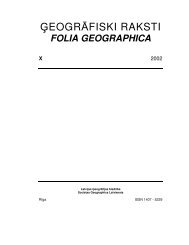eogrÄfiski raksti folia geographica xii - Ä¢eogrÄfijas un Zemes zinÄtņu ...
eogrÄfiski raksti folia geographica xii - Ä¢eogrÄfijas un Zemes zinÄtņu ...
eogrÄfiski raksti folia geographica xii - Ä¢eogrÄfijas un Zemes zinÄtņu ...
You also want an ePaper? Increase the reach of your titles
YUMPU automatically turns print PDFs into web optimized ePapers that Google loves.
MAN AND ENVIRONMENT<br />
forests have appeared. On the other hand, it is heterogenisation, resulting in the appearance of<br />
mosaic-type landscape in <strong>un</strong>dulating areas.<br />
Figure 6. Map of land quality in the Gudenieki parish<br />
Explorations of Vidzeme Uplands [Nikodemus et al. 2004; Grīne et al. 2003] and studies<br />
of tendencies in land use in Gudenieki parish show that great transformations in landscape<br />
structure have taken place after the restoration of Latvia’s independence. The transformations<br />
mainly affect agricultural lands laid fallow and gradually turning into brushland. At the present<br />
time agricultural lands with managed drainage are used intensively. They occupy the greatest<br />
part of the territory of the parish. Extensive tracts of agricultural lands are cultivated by Danish<br />
farmers. They are better provided with agricultural machinery and the latest technologies than<br />
local farmers. The territory farmed by Danes constitutes 1941 hectares or 17% of all agricultural<br />
land in the parish. The <strong>un</strong>drainaged meadows and pastures gradually turn into brushland<br />
(Figure 7). Disappearance of wetlands and grasslands has resulted in deterioration of the<br />
environmental structure of the landscape, which in its turn is a threat to the biological diversity<br />
of the landscape [Poudevigne et al. 1997]. As studies in Latvia show, transformation of<br />
agricultural lands, including meadows and pastures, into woodland, affects not only the visual<br />
quality of the landscape but also its biological diversity [Priednieks et al. 1999]. In the abovementioned<br />
restricted area in Gudenieki parish j<strong>un</strong>ipers give way to brushland.<br />
When comparing changes in the mosaic-type landscape in the Taurene parish of Vidzeme<br />
Uplands [Grīne et al. 2003] and in Gudenieki parish of Rietumkursa Uplands, one can see that,<br />
despite similar relief, the process of overgrowing with brush is less intensive in Gudenieki<br />
parish than in Taurene parish. Partly it is due to the fact that, as mentioned before, a large part<br />
of agricultural land is cultivated by Danish farmers. Moreover, Kurzeme has long-standing<br />
farming traditions. During the period of the First Independent State of Latvia Kurzeme had a<br />
greater number of large scale farms (with over 50 hectares) than Vidzeme, a factor<br />
economically and psychologically favouring agricultural land use. It proves the earlier<br />
expressed assumption [Nikodemus et al. 2004; Grīne et al. 2003] that at the turn of the<br />
62

















